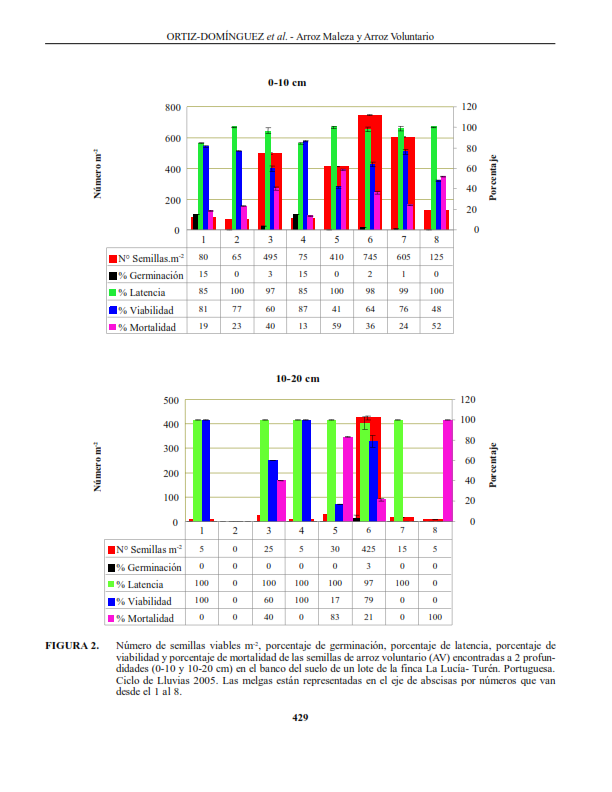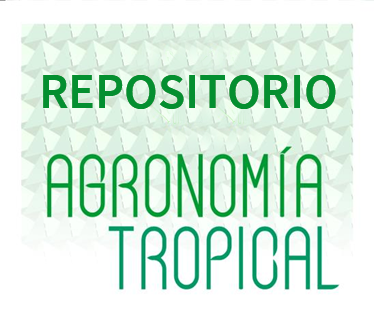Evaluation of weedy rice and volunteer rice soil seed bank in one lot of La Lucía farm
Abstract
Weedy rice (WR), Oryza sativa L., is one of the main weeds in Venezuela. The purpose of this study was to evaluate, the WR and volunteer rice (VR) soil seed banks at 8 seedbeds that represent 24 ha of a rice farm of 500 ha, in Portuguesa, Venezuela. The sampling was realized in double diagonal. We excavated trench to extract soil samples to 0-10 and 10-20 cm deep, where was evaluated: (1) passive bank, counting seeds present in the soil sampling, and (2) active bank, placing the soil in plates and counting the emerged seedlings. The results showed that in the depth of 0-10 cm were found more seeds of WR than in 10-20 cm. Therefore, the density in the passive bank fluctuated between 230-2825-WR seeds m-2. In all the seedbeds, the seeds on the surface had higher seed viability than the seeds that were found deeper. In both depths, the viable seeds showed more of 90% of dormancy. This was corroborated with the technique of emergence in the plate, which showed a lower density of WR seedlings compared with the number of seeds found in the same points of the sampling and which represented the WR active seed bank, with the following distribution pattern: The first two seedbeds did not show WR, the last three seedbeds showed low population (55, 25 and 55 seedlings m-2, respectively) and the seedbeds on the middle had the highest density of WR (135, 391 and 65 seedlings m-2).
Downloads
References
• Andrés, A., L. Ávila, E. Marchezan e V. Menezes. 2001.Rotação de culturas e pousio do solo na redução do banco de sementes de arroz vermelho em solo de várzea. Rev. Bras. de AGROCIÊNCIA 7(2):85-88.
• Ávila, L., A. Andrés, E. Marchezan e V. Menezes. 2000. Banco de sementes de arroz vermelho em sistemas de semeadura de arroz irrigado. Ciência Rural, SantaMaria. 30(5):773-777.
• Baskin, C. and J. Baskin. 2001. Germination ecology of seed in the persistent seed bank. In: Seeds ecology, biogeography, and evolution of dormancy and germination. C. Baskin and J. basking Ed. Academic Press. 133-179 p.
• Brenes, B., R. Agüero y A. Rodríguez. 2006. Distribución espacial y densidad de poblaciones de arroz rojo (Oryza sativa L.) en dos sistemas de labranza. Agronomía Mesoamericana 17(1):35-39.
• Burgos, N., V. Shivrain, D. Gealy and H. Black. 2004.Planting date matters in Clearfield rice outcrossing. Proc. Ark. Crop Protect. Assoc. Res. Conf. 8:7.
• Chauvel, B., J. Gasquez and H. Darmency. 1989. Changes of weed seed bank parameters according to species, time, and environment. Weed Res. 29:213-219.
• Delouche, J, N. Burgos, D. Gealy, G. Zorrilla y R. Labrada. 2007. Arroces maleza-origen, biología y control. Organización de las Naciones Unidas para la Agricultura y la Alimentación (FAO). Roma. 157 p.
• Diamond, J. 1999. Up to the starting line. In: Guns Germs, Steel. The fates of human societies. New York (NY): WW Norton & Company 35-52 p.
• Ewel, J., A. Madriz y J. Tosi Jr. 1968. Zonas de vida de Venezuela: Memoria explicativa sobre el mapa ecológico. 2da edición. MAC-FONAIAP. Caracas. Venezuela.
• Ferrero, A. and F. Vidotto. 1999. Red rice control in rice pre-and post-planting. In: FAO. Global workshop on red rice control. Report of Workshop. Varadero, Cuba. Plant Production and Protection Division. Rome. 155 pp.
• Forcella, F. 1997. La aplicación de la ecología del banco de semilla en el manejo de malezas. In: consulta con expertos en ecología y manejo de maleza. Roma, Italia. Resúmenes p. 27-40.
• Forcella, F., T. Webster and J. Cardina. 2003. Protocols for weed seed bank determination in agroecosystems. In: Weed management for developing countries. Addendum 1. Food and Agriculture Organization of the United Nations (FAO). Roma. 18 p.
• Gealy, S. 2005. Gene movement between rice (Oryza sativa) and weedy rice (Oryza sativa): a temperate rice perspective. In: J. Gressel (ed.), Crop Ferality and Volunteerism. CRC Press, Boca Ratón, FL, Estados Unidos de América. 323-354 p.
• Gealy, D., D. Mitten and J. Rutger. 2003. Gene flow between red and herbicide-resistant rice: implications for weed management. Weed Technol. 17:627-645.
• International Seed Test Association (ISTA). 1993. International rules for seed testing. Annexes. Seed Sci. &.Technol.21supplement.Zurich, Switzerland. 288 p.
• Kissmann, K. and D. Groth. 1997. Plantas Infestantes e Nocivas. BASF. 2a Edicao. Tomo I, II y III. Brasil. 825 p.
• Lorenzi, H. 1994. Manual de Identificacao e controle de plantas daninhas, plantio directo e convencional. 4ta Edición. Edt. Plantorum LTDA. Brazil. 440 pp.
• Machado, J. 2006. Seguimiento de la Calidad en la Semilla de Arroz. Senasem-Portuguesa: Caso arroz Rojo. Ciclo de charlas. Instituto Nacional de Inves tigaciones Agrícolas (INIA). 22 p.
• Malone, C. 1967. A rapid method for enumeration of viable seeds in soil. Weeds 15:381-382.
• Medina, D. e I. Dorante. 1996. Manual de identificación de maleza en el cultivo de arroz bajo riego en Venezuela. APROCELLO. Acarigua. Portuguesa. Venezuela. 20 p.
• Montealegre, F. y J. Clavijo. 1994. Efectos ambientales y genéticos en la germinación y dormancia de los arroces rojos. COMALFI. 21(2):20-26.
• Navarro, J. y E. Pérez. 2001. Estimación del tamaño, forma y número óptimo de muestras para evaluar el banco de semillas de malezas en un campo de arroz (Oryza sativa L.). Trabajo de Grado. Maracay, estado Aragua, Ven. Universidad Central de Venezuela. Facultad de Agronomía. 60 p.
• Noldin, J. 1995. Characterization, seed longevity, and herbicide sensitivity of red rice (Oryza sativa L.) ecotypes, and red rice control in soybeans [Glycine max (L.) Merr.] Ph. D. Dissertation. Texas A & M University, College Station, TX. United States. 218 p.
• Ortega, Y. y R. Agüero. 2005. Efectos de dos sistemas de labranza sobre poblaciones de arroz rojo (Oryza sativa L.) en un agroecosistema arrocero inundado. Agronomía Mesoamericana. 16(1):63-75.
• Ortiz, A. 2000. Efecto de algunos ecotipos de arroz rojo sobre el rendimiento en molino y transparencia de los cultivares del arroz Fonaiap 1, Cimarrón y ZETA 15. Agronomía Trop. 50(4):633-642.
• Ortiz, A. 2005. Manual de evaluación del banco de semillas de arroz rojo (arroz maleza) en el suelo. Universidad Central de Venezuela. Facultad de Agronomía. Desplegable. 12 p.
• Ortiz, A. y L. González. 2001. Estudio preliminar del banco de semillas de malezas del suelo de algunas zonas arroceras de calabozo, Guárico. Agronomía Trop. 51(4):501-517.
• Ortiz, A. y M. Ojeda. 2006. Evaluación del efecto de diferentes proporciones de granos paddy de varietales de arroz maleza sobre la calidad molinera de variedades de arroz. Agronomía Trop. 56(2):199-218.
• Ortiz, A., A. Pérez, J. Ochoa y J. Lazo. 2007. Caracterización del arroz rojo proveniente de lotes de semilla de arroz. Parte I. Agronomía Trop. 57(3):147-156.
• Ortiz, A., D. Torrealba y S. Fazio. 2004. El tiempo de interferencia de arroz rojo sobre el rendimiento de las variedades Cimarrón y FONAIAP 1. Agronomía Trop. 54(3):293-308.
• Ortiz, A. y S. Torres. 2004. La densidad de arroz rojo sobre el rendimiento y sus componentes de la variedad de arroz ZETA 15. Agronomía Trop. 54(3):321-330.
• Torres, S. 2003. Efecto de densidades de población de arroz rojo (Oryza sativa L.) sobre el rendimiento y calidad molinera de la variedad de arroz ZETA 15. Trabajo de Grado. Maracay, estado Aragua, Ven. Universidad Central de Venezuela. Facultad de Agronomía. 66 p.
• Teekachunhatean, T. and J. C. Delouche. 1986. Release of dormancy in red rice seed under field conditions in Mississippi. Proc. 23rd Rice Tech. Working Group Mtg. (Beaumont, TX). United States. 23:61.
• Thompson, K. and J. Grime. 1979. Seasonal variation in the seed Banks of herbaceous species in ten contrastings hábitats. J. Ecol. 67:893-921.
• Velásquez, J. 1993. Semillas de plantas acuáticas vasculares del Sur del Estado Anzoátegui. Edt. CORPOVEN filial de PDVSA. Caracas, Venezuela. 47 pp.
• Wiles, L. and E. Schweizer. 1999. The cost of counting and identifying weed seeds and seedlings. Weed Sci. 47:667-673.
• Yenish, J., P. Doll and D. Buhler. 1992. Effects of tillage on vertical distribution and viability of weed in soil. Weed Sci. 40:429-433.





